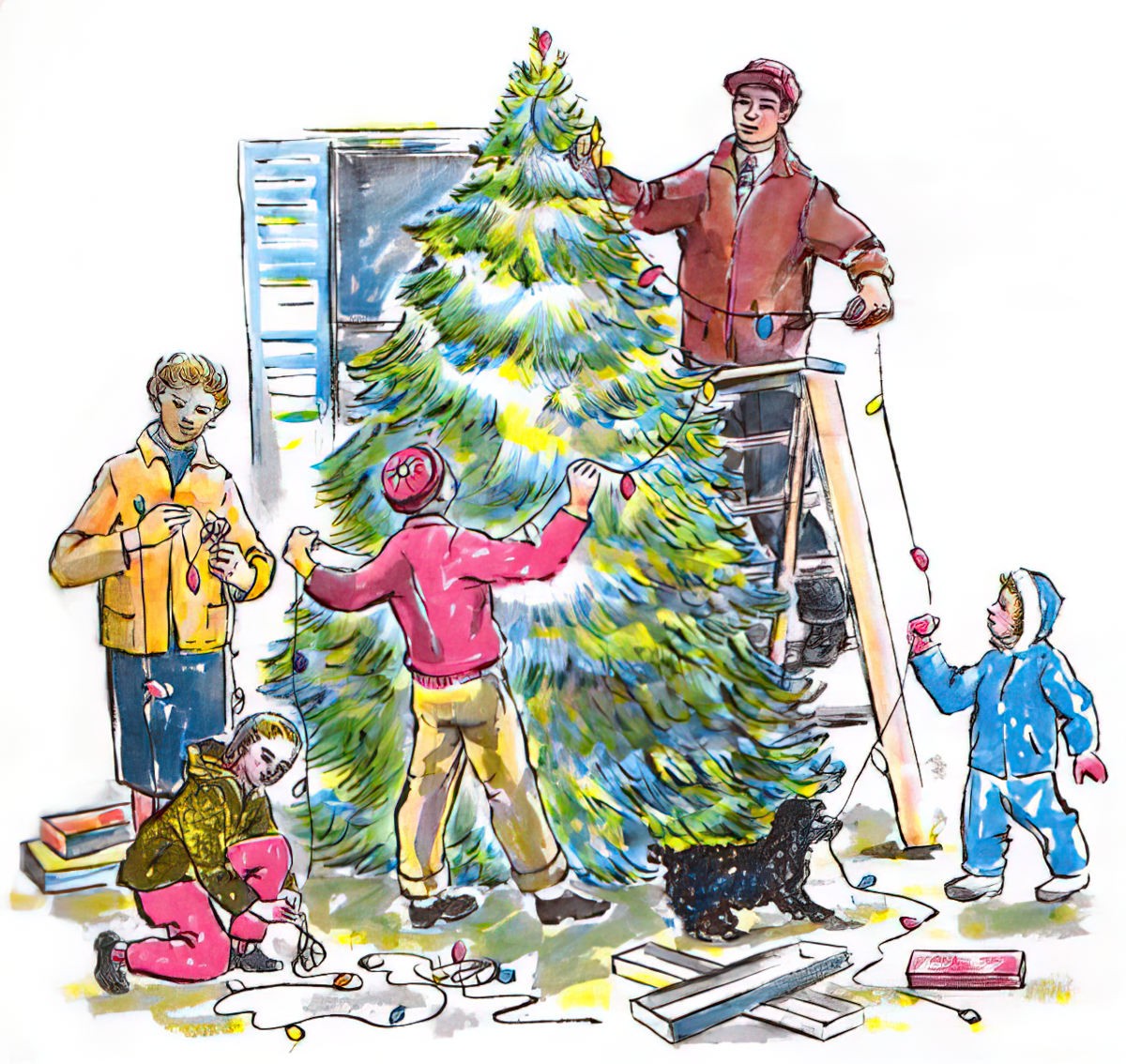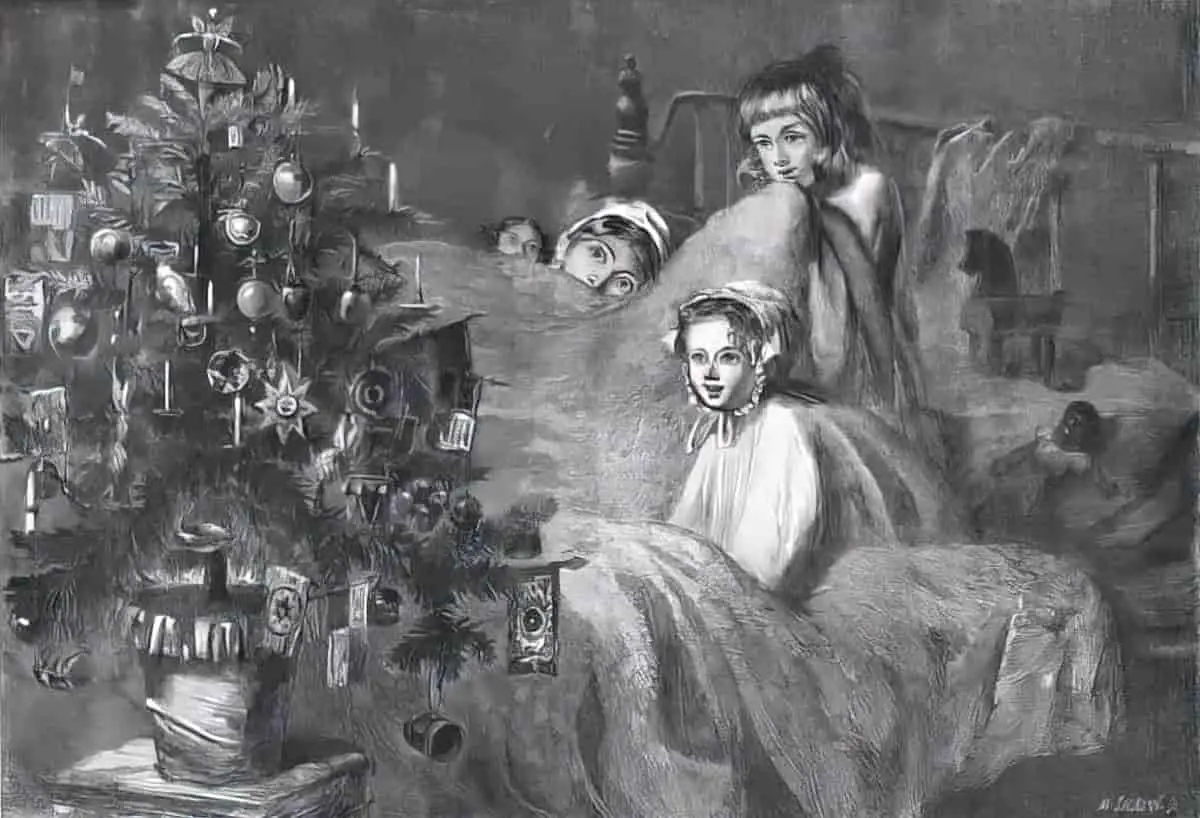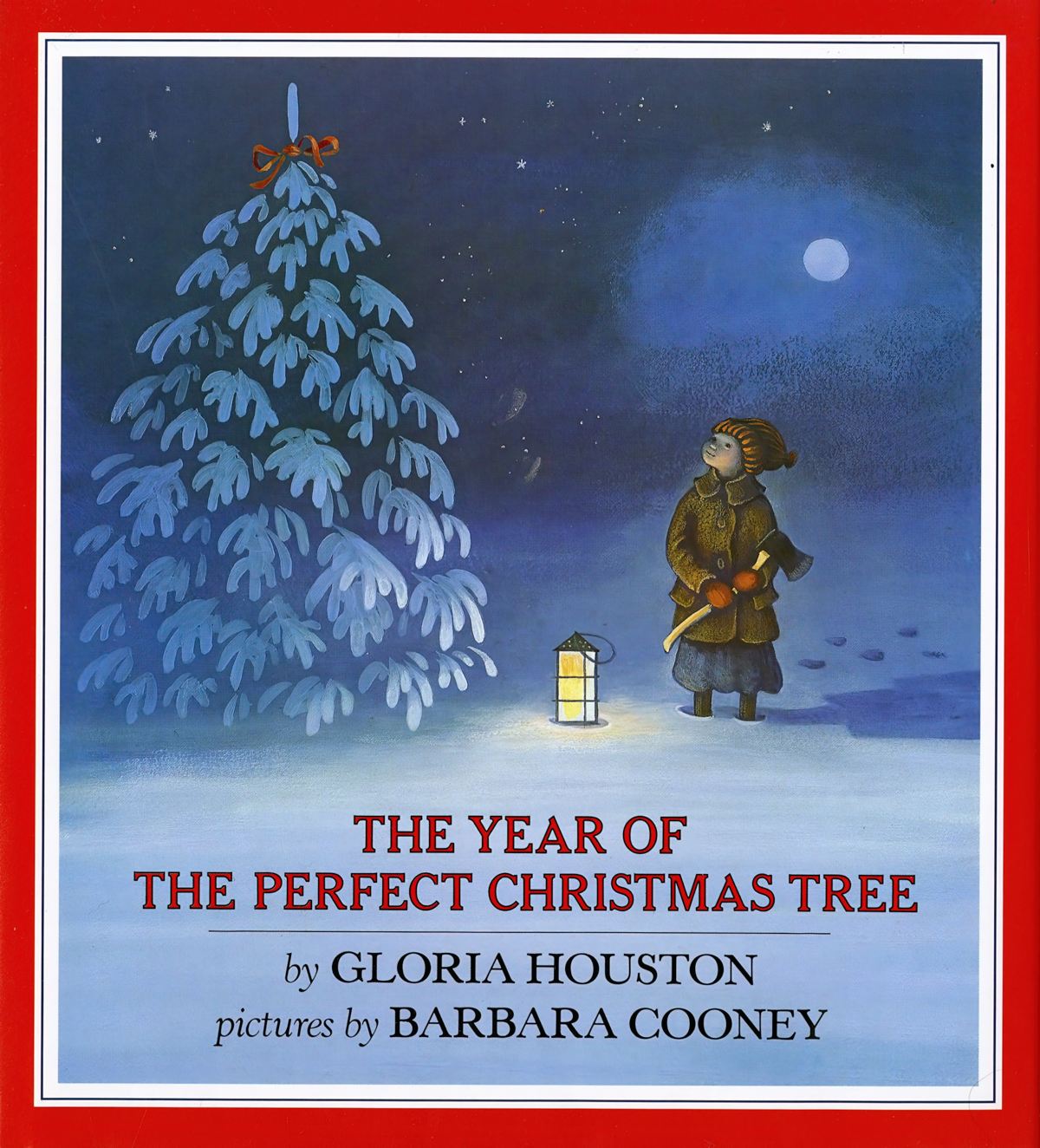“The Year Of The Perfect Christmas Tree: An Appalachian Story” (1988) is a picture book written by Dr Gloria Houston, illustrated by Barbara Cooney (1917-2000). You’ll soon realise this picture book is longer than almost all contemporary picture books, which are overwhelmingly pitched at pre-schooler length. This one is an excellent example of a ‘picture book for all ages’, designed to be read as a family on Christmas Eve.
Ingredients for cosy stories:
- snow covered nights
- communities coming together to do something in unison (singing or rowing or something like that)
- well-appointed log cabins
- a garden which provides
- a mother in an apron tucking you into bed
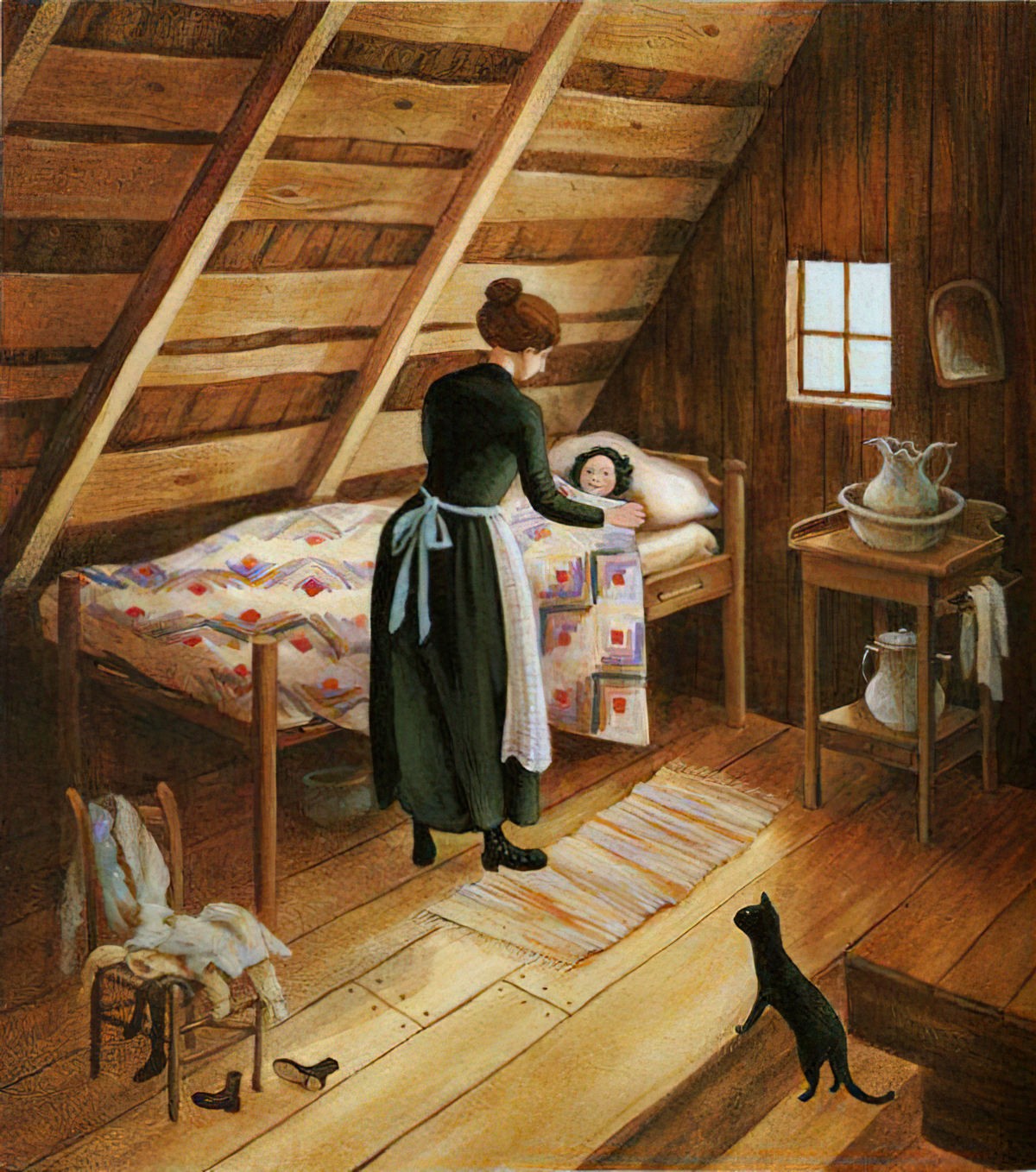
PARATEXT
This unforgettable tale, illustrated by Caldecott Medallist Barbara Cooney, has become a seasonal classic-a touching and joyful story about courage and the power of family.
marketing copy
The Armistice has been declared, but still there is no sign of Ruthie’s father in their little Appalachian town. So, in accordance with the traditions of Pine Grove, it falls to Ruthie and her mother to bring home the perfect Christmas tree to donate to the town. Ruthie had accompanied her father to the rocky cliff where he marked a tree in the spring, so she and her mother set out to find it again, and haul it home. Their trip becomes the basis overnight of a new town legend; [meanwhile] Ruthie [is] chosen for the role of the heavenly angel in the the church Christmas play…
from the publishers
SETTING OF “THE YEAR OF THE PERFECT CHRISTMAS TREE”
PERIOD
It is the year 1918. So what exactly was happening? What is “Armistice”? An armistice is a truce, or an agreement to stop fighting.
In 1918, on 11 November, an armistice was signed which ended fighting on land, sea and air. On the losing side, Germany was the last territory standing.
The United States entered WW1 in April 1917, more than two and a half years after the war began in Europe. Americans had just come out of a Depression and had overwhelmingly wanted to stay out of it. But they could clearly see that Germany was the aggressor in Europe.
When it seemed Germany was in danger of gaining power, that’s when America decided to step in.
Poor white American farmers at the time commonly said, “a rich man’s war meant a poor man’s fight.” The more education you had, the more likely you were to support American intervention in the war. Ruthie’s father may not have paid much attention to it, busy on his farm in the Appalachian Valley, but he probably started to pay more attention after 1915, with the sinking of the Lusitania after German submarines decided to sink ships in the waters around The British Isles. The ship took just 18 minutes to sink after being hit by a torpedo. This ship had left New York with 1198 people onboard, and naturally made Americans at home feel this European war included them.
DURATION
The story starts in early spring, when Papa takes Ruthie to choose the Christmas tree. In the summertime, Papa is “called away to be a soldier”.
LOCATION
Appalachia, in a township called Pine Grove. The township is nestled in a valley, which makes its inhabitants feel protected from the outside world.
Appalachia is a cultural region in the Eastern United States stretching from the Southern Tier of New York State to northern Alabama and Georgia.
By the end of World War I, approximately 72% of American troops were draftees, a much higher percentage than in earlier US wars.
That said, Georgia had the most volunteers to fight in WW1 per capita before conscription. Ruthie’s father was living in and around a culture where men tended to believe it their duty to fight for freedom in Europe.
America has long been very proud of its freedom, and is willing to fight for it on others’ behalf. Note the title of this N.C. Wyeth painting below (created during the next World War).
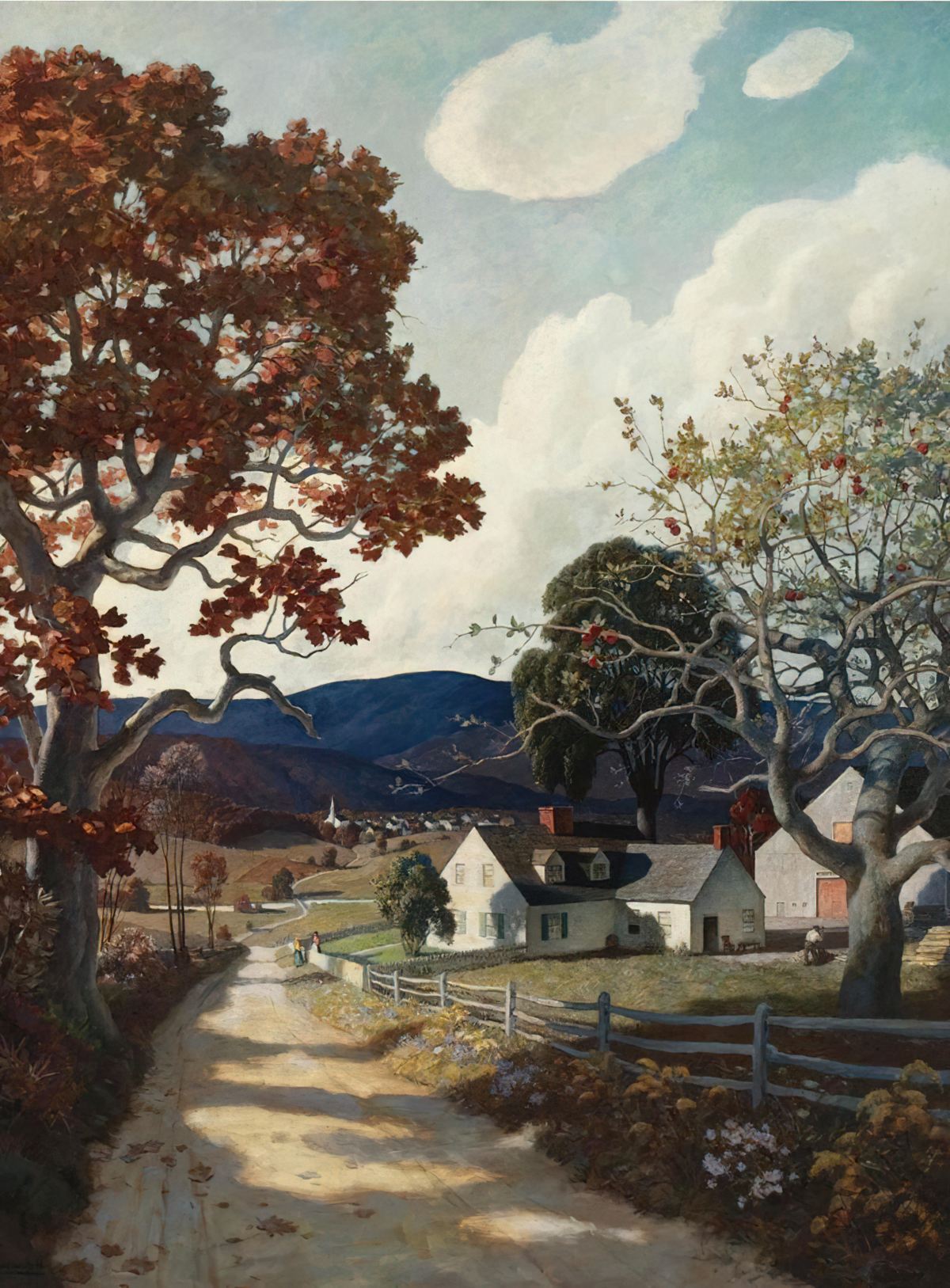
He would have been caught up in the third round of conscription. The first American men were sent in June the previous year. All men between the ages of 21 and 30 were eligible to register. In June the following year, same thing, this time sweeping up young men who had just turned 21. But in September of 1918, when this picture book begins, no able-bodied man between 18-45 was safe from the pressures of combat. This included men such as Ruthie’s father.
Unmarried men with no dependants were first on the chopping block. Class one. Ruthie’s father was of course married and had a dependant, so he would have been in class two, unless his ‘agricultural labor’ was deemed essential to the war effort, in which case class three.
When class one dwindled, class two men were sent, and so on. Once Papa’s cohort reached Europe, the war ended pretty swiftly after.
ARENA
The small town and the nearby wilderness, with brief mention of the wider world.
MANMADE SPACES
The people live in simple log cabins with enough land to farm food for their own households. Like “The Ox-Cart Man“, also illustrated by Barbara Cooney, this is subsistence living.
NATURAL SETTINGS
WEATHER
It snows in the mountains at Christmas time. Barbara Cooney is very good at depicting a vast landscape in a double spread.
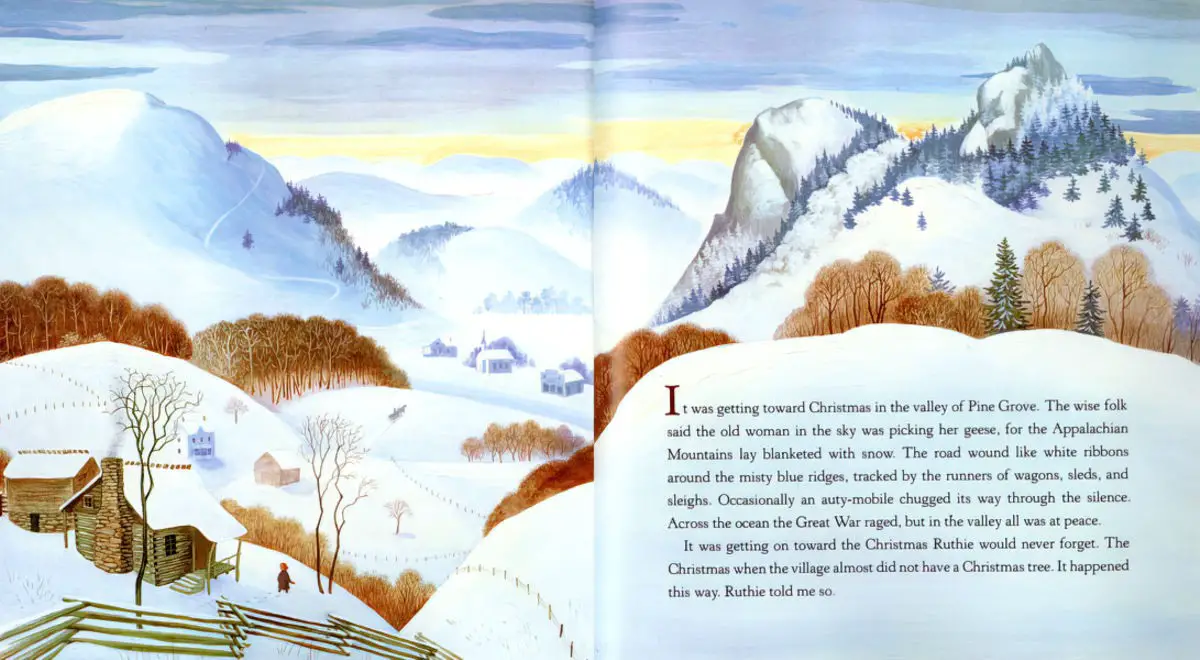
See also: An Entire World In A Single Illustration.
SENSORY EXPERIENCE
The Christmas tree is central. Importantly, the Christmas tree is balsam. These trees fill a room with the scent of fir, turning this story into a sensory experience to those who know the smell and associate it with Christmas.
Christmas songs are mentioned in the picture book:
- “Jesus, Jesus Rest Your Head” (an Appalachian lullaby)
- “I wonder as I wander out under the sky” (another Appalachian song)
- Silent Night
Looks like the second song is anachronistic — it didn’t exist at the time of the story:
“I Wonder as I Wander” is a Christian folk hymn, typically performed as a Christmas carol, written by American folklorist and singer John Jacob Niles. The hymn has its origins in a song fragment collected by Niles on July 16, 1933.
Wikipedia
Silent Night is a Christmas staple:
LEVEL OF CONFLICT
There are two levels to this one:
- For children there’s the relatively low-stakes challenge of providing the Christmas tree and wearing the appropriate costume for a performance
- For adults there’s the very real fear that Papa won’t be coming back. Due to the phenomenon of backshadowing, adults understand many men did not come back from that war, despite promising they would, no doubt.
THE EMOTIONAL LANDSCAPE
Ruthie doesn’t understand the realities of war, and this is to her advantage. Of course, her mother is protecting her from it, and succeeding. But when the mother sits down to sacrifice her precious wedding dress for her daughter’s costume, what must she be thinking? To her, there’s the very real possibility that she’ll never see her husband again.
But rather than hold onto a precious item the two of them shared, she will make this Christmas special for Ruthie. It may be the last one she gets of her childhood, if her father isn’t about to return from the war.
STORY STRUCTURE OF “THE YEAR OF THE PERFECT CHRISTMAS TREE”
The narrative utilises story-within-a-story structure to remind us these events happened long ago and what happened then continues to have resonance for people who live in this area.
It was getting on toward the Christmas Ruthie would never forget. The Christmas when the village almost did not have a Christmas Tree. It happened this way. Ruthie told me so.
“The Year Of The Perfect Christmas Tree”
SHORTCOMING
Ruthie and her Papa select a perfect balsam tree to be the Christmas for the village when it is Ruthie’s turn to play the angel at the Christmas performance. But before the tree can be cut down from the difficult-to-access ridge, Papa must go to war.
As Christmas draws nearer, that village in the Appalachian mountains wonders where they will get a tree for Christmas Eve.
DESIRE
The Pine Grove Church chooses one family each year to supply the Christmas tree, and because church is central in the lives of the villagers, it is essential to find a really good one and to provide it by the due date.
During the spring before Papa left for the war, he and Ruthie climbed to the top of the rocky ridge to pick out the perfect tree. Papa tied one of Ruthie’s hair ribbons to the tree. Makes you wonder if he anticipated leaving for war doesn’t it?
I’m starting to think tying ribbons to trees during times of war is a whole thing:
Did you notice how the road out of the mountain was compared to a white ribbon? The ribbon motif is multivalent: femininity and also a road back home (for the father, after war). When mother and daughter insist on finding the tree with the ribbon, they are connecting with Papa.
Anyway, as part of providing the tree, Ruthie gets to be the heavenly angel in the play — a super coveted position!
In her prayer each night she wants her father home from war and also for Christmas she wants a doll with a beautiful dress. A comic juxtaposition when you think about it, typical of young kids. “Please end world hunger and also can I have a bag of licorice allsorts for my birthday.”
OPPONENT
Well, the war.
The war removes the father, which is both requires and allows mother and daughter to make the trek alone to retrieve the tree. We were told at the beginning of the story that this is a job for a man, and I really don’t think the father was using universal ‘man’ here. I’m looking at that tree, I’m looking at that little girl, and I’m thinking the woman cut and hefted that tree all on her own while also taking care of a small, frightened child at night.
But what about that preacher? How horrible is he? I wouldn’t put him in charge of a pickle jar let alone a congregation. “I hoped you’d heed my wish.” No, “I bet you must be worried about your Tom.” No concern for human welfare. Guy’s obsessed with the damn tree when it’s his actual job to provide comfort and solace in difficult times.
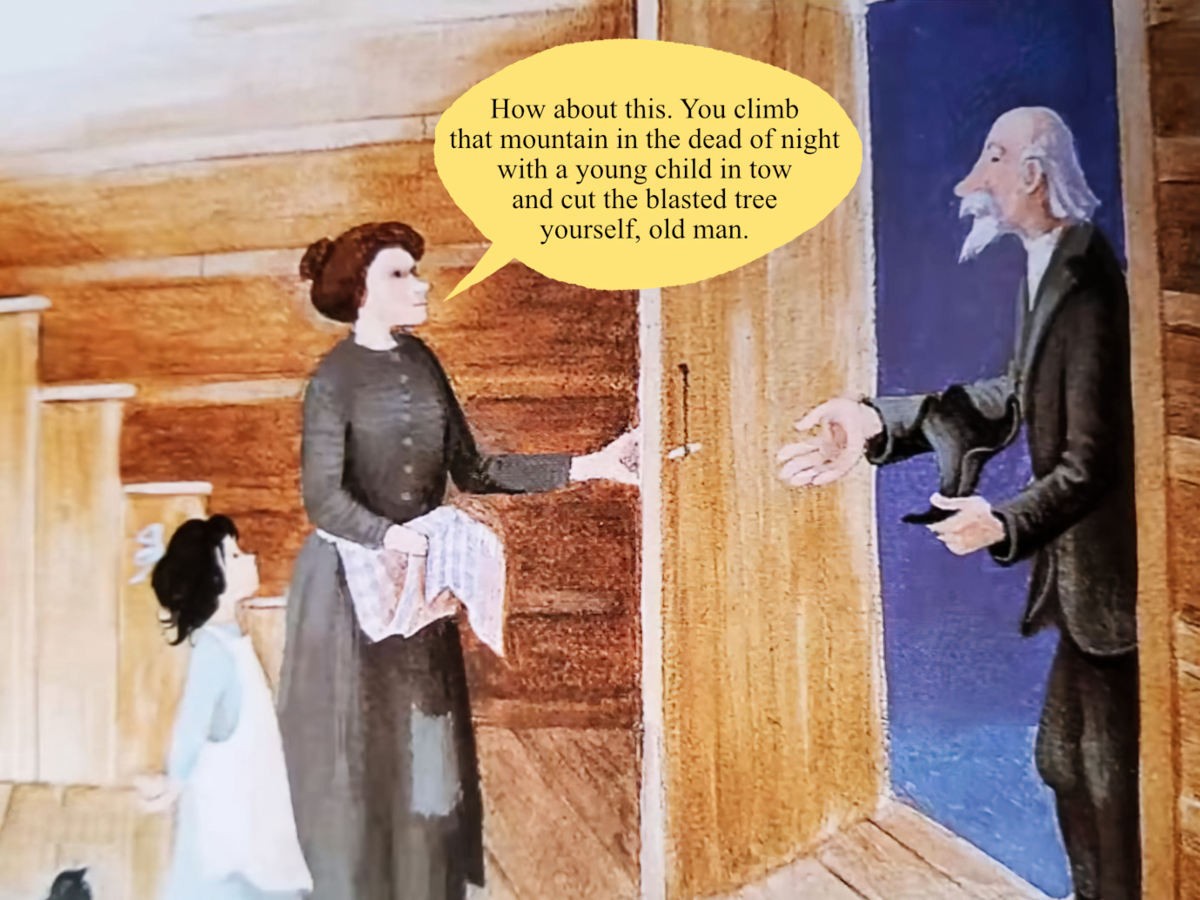
The classroom teacher isn’t helping. Any parent who’s had to knock up a costume with limited time and perhaps limited budget knows how much pressure costumes can put on a family. I suspect the teacher is trying to persuade Ruthie that her regular sleeves are enough to make good angel wings, but if that what’s the old woman’s trying to do, it doesn’t quite work. Ruthie goes home and requests massive sleeves, in a scene straight out of Anne of Green Gables.
Speaking of which, this classroom could be a scene out of the TV adaptations. Barbara Cooney loved her pot-bellied stoves. She included them in most of her books. They have a very feminine shape to them, by coincidence, and this is a feminine story, along with Miss Rumphius and Emma.
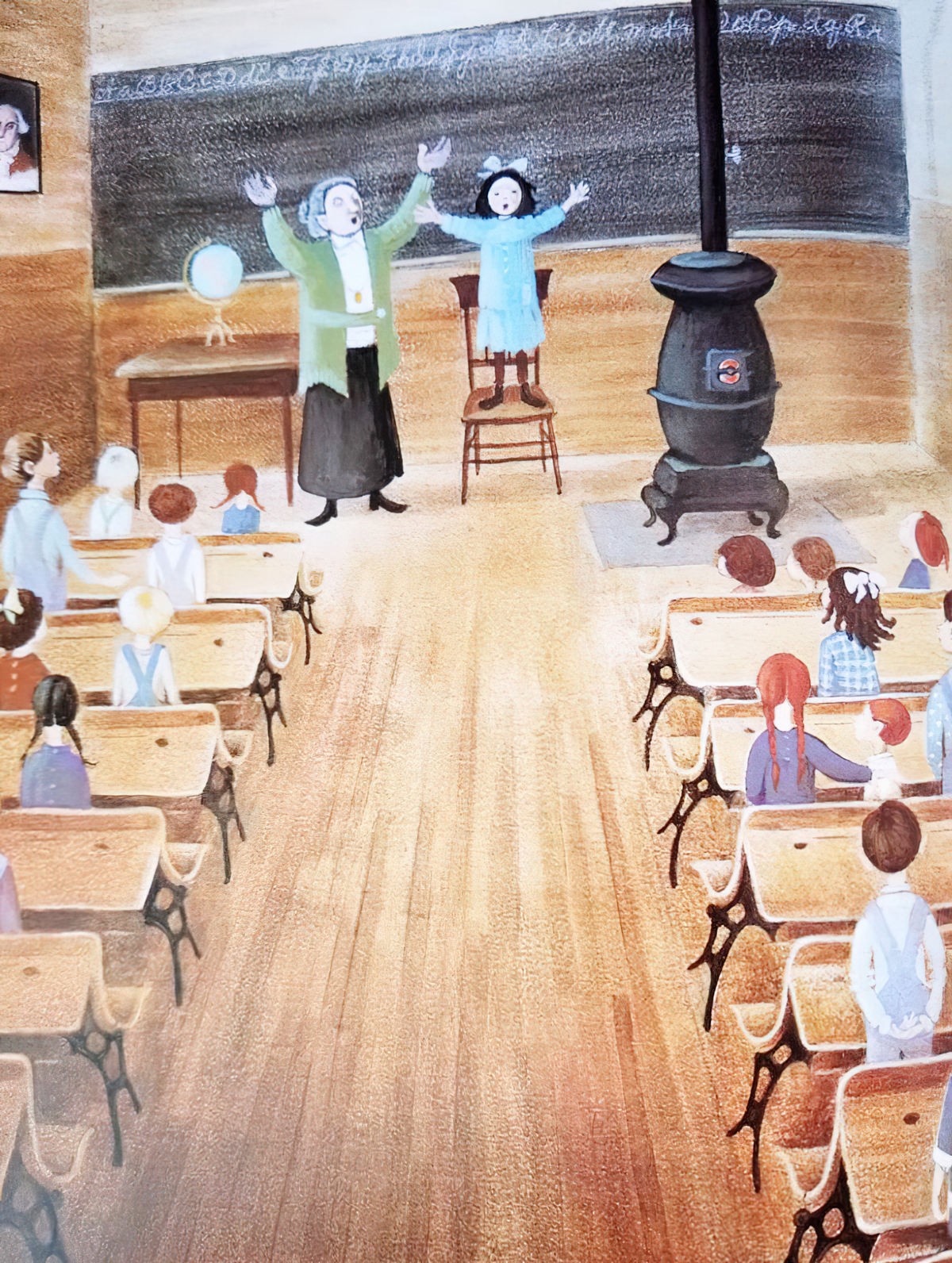
Let’s all take another long gander at that tree and imagine how heavy that thing was.
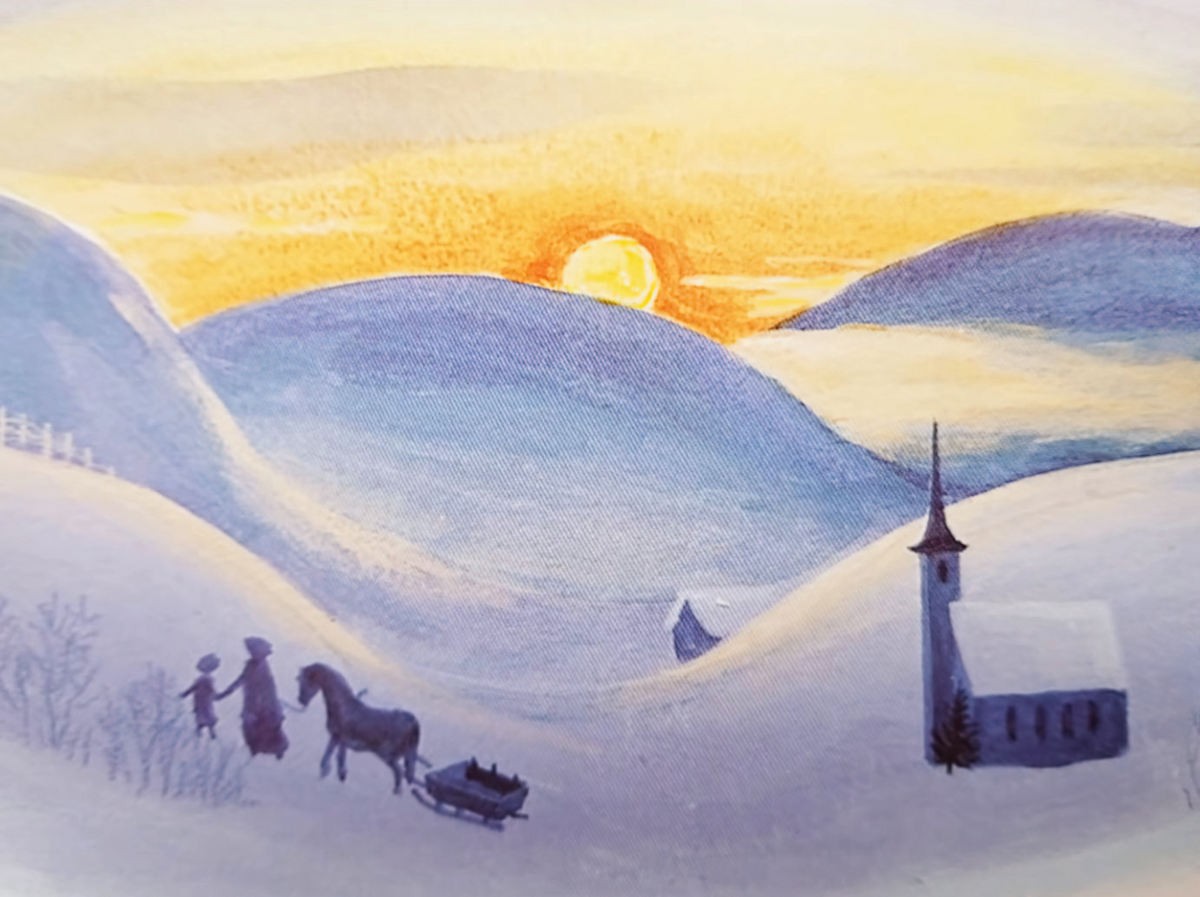
PLAN
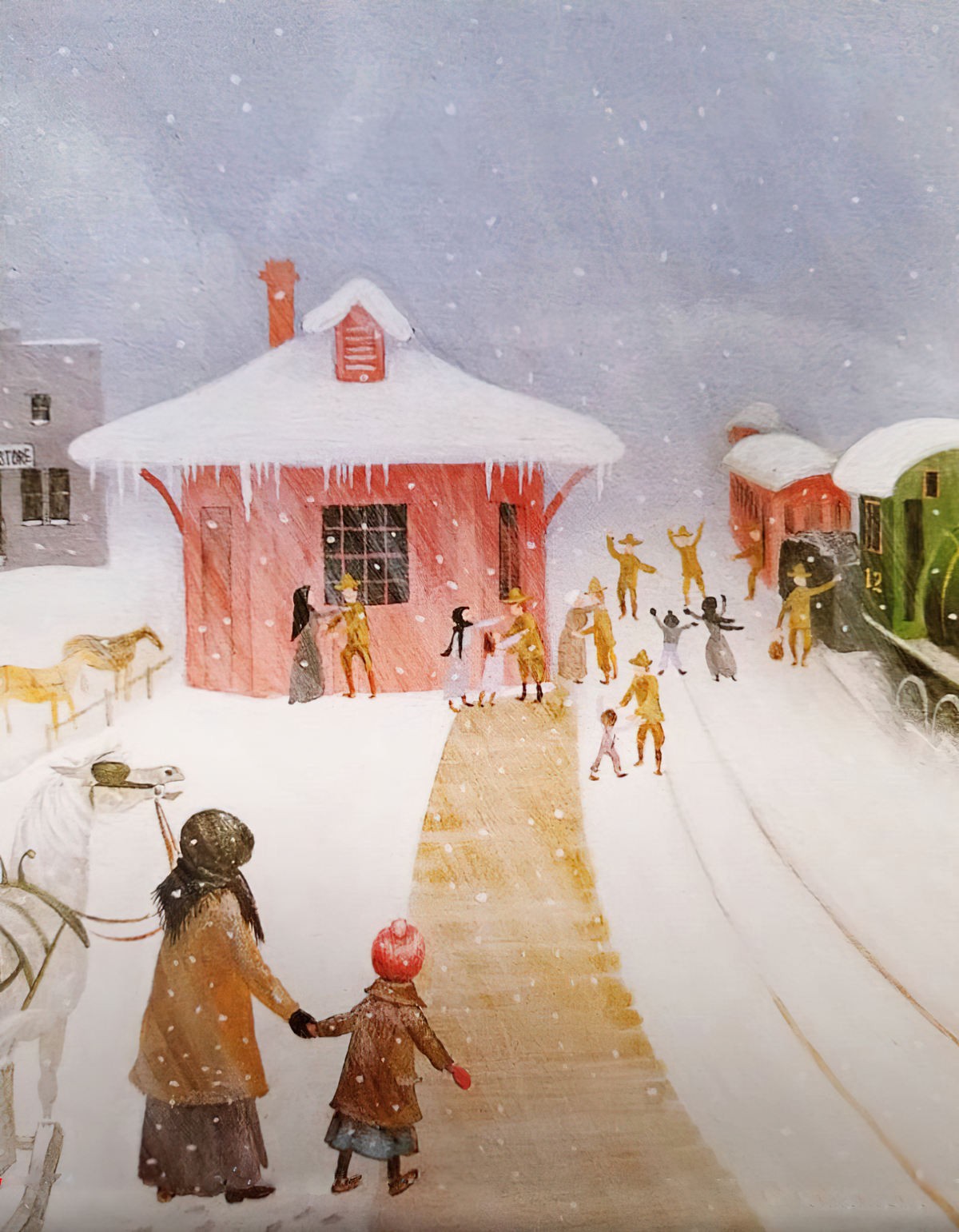
Mother and young daughter cannot let the church community down so in the middle of the night, after the mother realises her husband will not be coming home in time to cut it down himself, she takes her daughter on a night-journey to cut it down herself.
For Ruthie, this is an exciting adventure a la “Bears In The Night“.
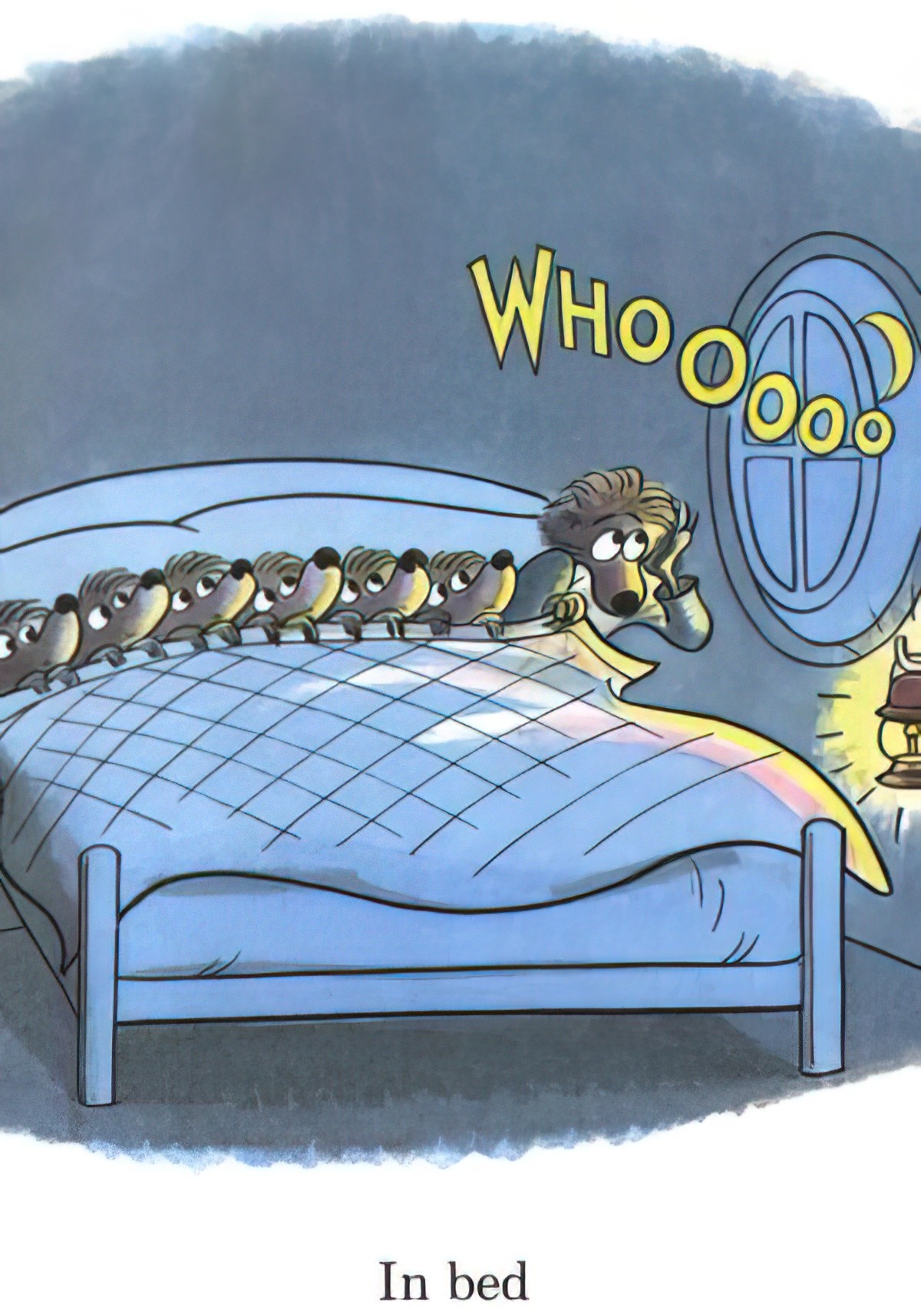
Once home, Ruthie gets a good night’s sleep — evidence that she’s not at all worried about her Papa. He’s never let her down before so he won’t this time.
But the mother, on the other hand. She’s up all night. Something happened up on that mountain (where revelations generally take place, especially when The Bible is palimpsest). And that revelation was pretty darn grim. He ain’t coming home. Better make this Christmas special as can be, because childhood won’t be the same for Ruthie after she realises she doesn’t have a father.
THE BIG STRUGGLE
The night journey is exciting and treacherous and they almost don’t find the one with the ribbon. Given they only have one of those old-timey lanterns, I’m mighty impressed they found it, let alone at night.
See: Lanterns and Street Lighting In Art And Illustration
ANAGNORISIS
So, the mother had a revelation: Her husband isn’t coming home. But she was wrong! Phew! She had a false anagnorisis. The father rocks up. Anyone who knew how many pages were left would’ve been reassured, because normally when the character is correct, the story hasn’t got much longer to go. (This is the problem with eBooks, you see. No natural sense of how much further there is left to the story. Progress bars simply don’t cut it.)
The real revelation is that the father does come back. So that tidies up the plot.
But what is this book about underneath all that? (Theme.)
Consumer reviews mention hope. This story turns out fine. Everyone did everything right. No one fell into a sobbing heap and gave up. The mother was industrious, supportive, and all her grief was happening on the inside. She sacrificed her most cherished item to make her daughter happy. It’s tempting to assume that because she did these things, that’s why the father came home. This connection is the cognitive bias which makes this story so comforting. We do not get the sad Christmas tale of the cabin over the hill, in which the father was killed in action leaving five young children and a sob-wracked widow. At least, not in a picture book. (If you’re up for that, check out the short stories of Annie Proulx.)
One consumer reviewer said how refreshing it was to see “an illustration of a Christmas tree depicted with the branches pointing upwards rather than most or virtually all depictions with drooping down branches.”
Not something I’d noticed myself, but I took another look. The tree on the cover is drooping down, sure enough. But here, the branches point up. The Christmas tree is personified, weighed down by snow when alone outside in the cold, but seemed to lift its arms as Ruthie her arms in song.
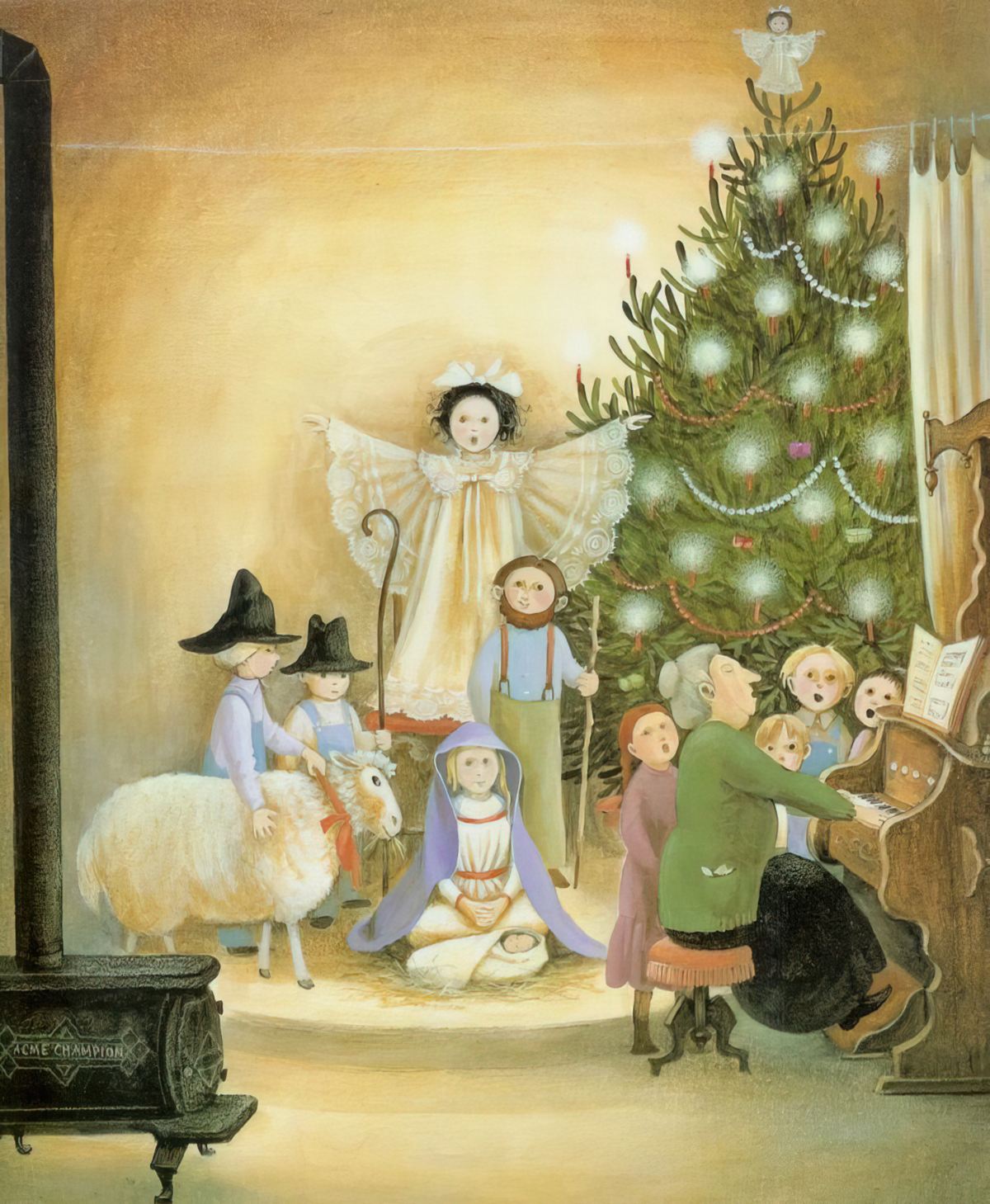
NEW SITUATION
Ruthie will go home and live safely with her mother and father, tucked up into bed as we have already seen her. This time she has not a care in the world.
For now…
EXTRAPOLATED ENDING
WW1 had caused so much destruction, people thought at the time that this had been “the war to end all wars”. Of course, we know from the vantage point of the 21st century that didn’t exactly pan out.
After Ruthie became a woman, a further generation of men were sent off to fight in the next World War. When adult Ruthie looked back on this Christmas of her childhood, she would have understood perfectly the worry in her mother’s mind, because she likely had a husband and sons and they would have been sent off to war, too. And, like her own mother, Ruthie would have stepped into the multifaceted roles required of her while the men were away.
RESONANCE
I’m tempted to say this is a timeless story, but actually? Times are a-changing. Contemporary readers are exposed to a lot more stories and some of us become a little weary of certain patterns.
A couple of things to consider, alongside enjoyment of this story:
- “The Year Of The Perfect Christmas Tree” is a celebration of austerity. Celebrations of austerity tend to be set during war time. Note that although this story was published in 1988, during a stretch of relative peace-time, many people live austere lives from birth to death, war or no war. By setting so many of our austerity stories during wartime, we paper over the reality that income inequality has never been so dire.
- Austerity in narrative can be idealised (or celebrated) when readers practise austerity by choice, meaning when there’s some control over how one might scrimp and save. However, austerity tales are far less cosy for readers experiencing the long-term grind of poverty.
- When fictional characters make material sacrifice and everything turns out okay in the end, and when these stories dominate, readers with privilege may fall into the trap of believing the mythology that no one would be living with the long-term grind of poverty if they, too, made true and genuine sacrifices like the mother of this tale. Ultimately, this is a celebration of individual sacrifice, meaning this is a tale of individualism.
- We get a taste of such binarism when the children deemed bad get a lump of coal as a gift, and must watch on in church as the children deemed good get a gift. What does it mean to be good? And what does it mean to be deserving of good fortune, such as your father coming home from war? This story rolls Ruthie’s goodness and the reward of her father’s return into one. (It helped that she had dimples.)
MORE EXAMPLES OF CHRISTMAS TREES IN ART & ILLUSTRATION
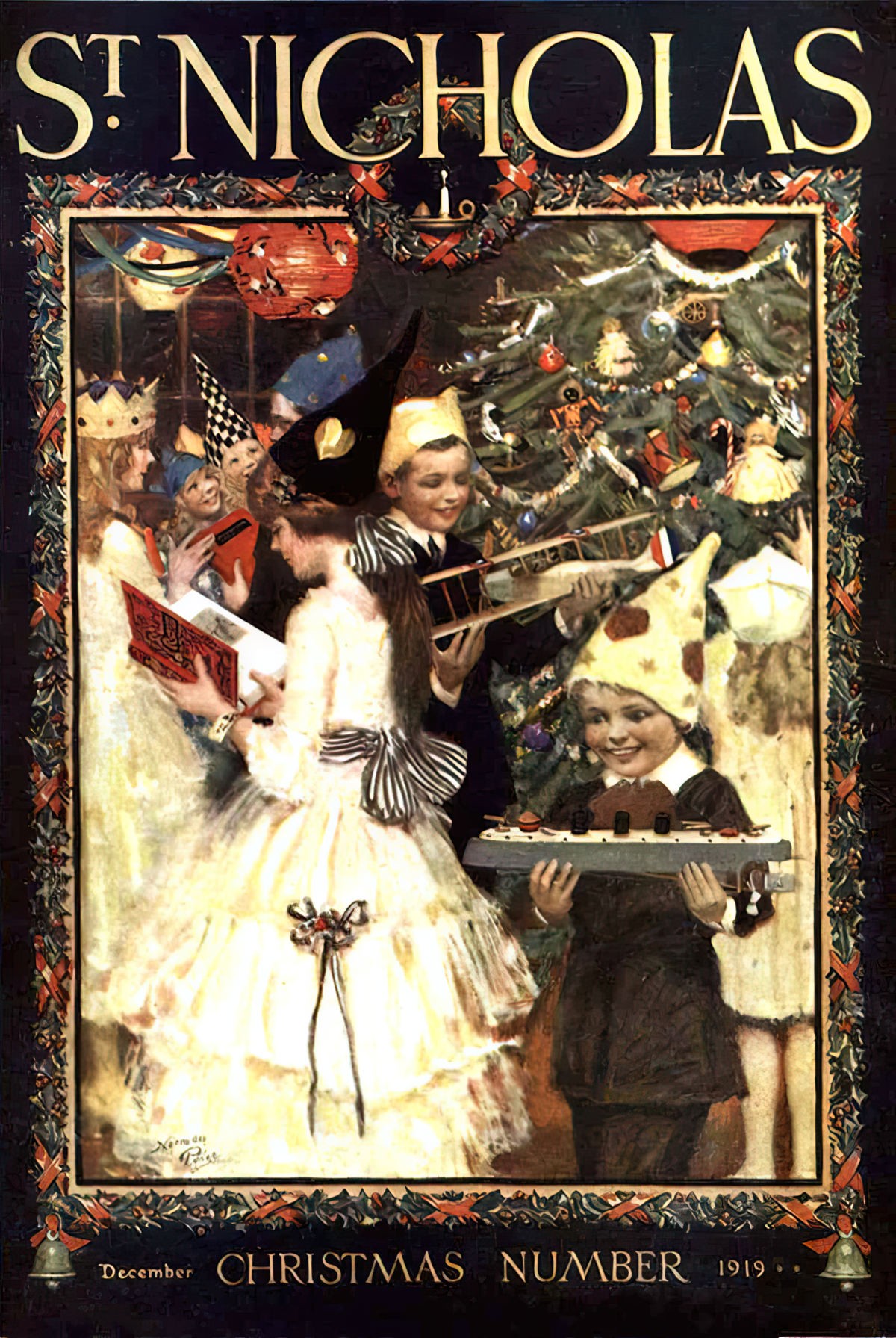
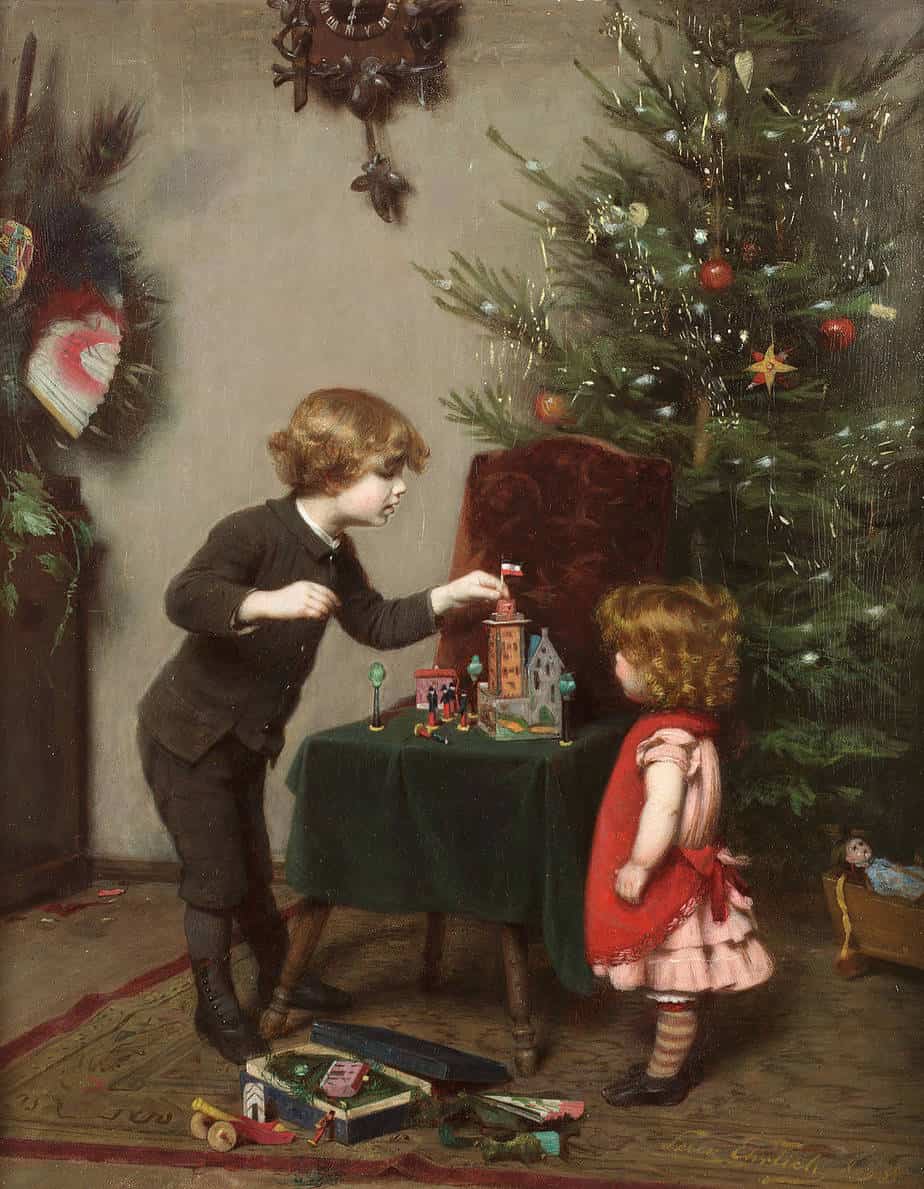
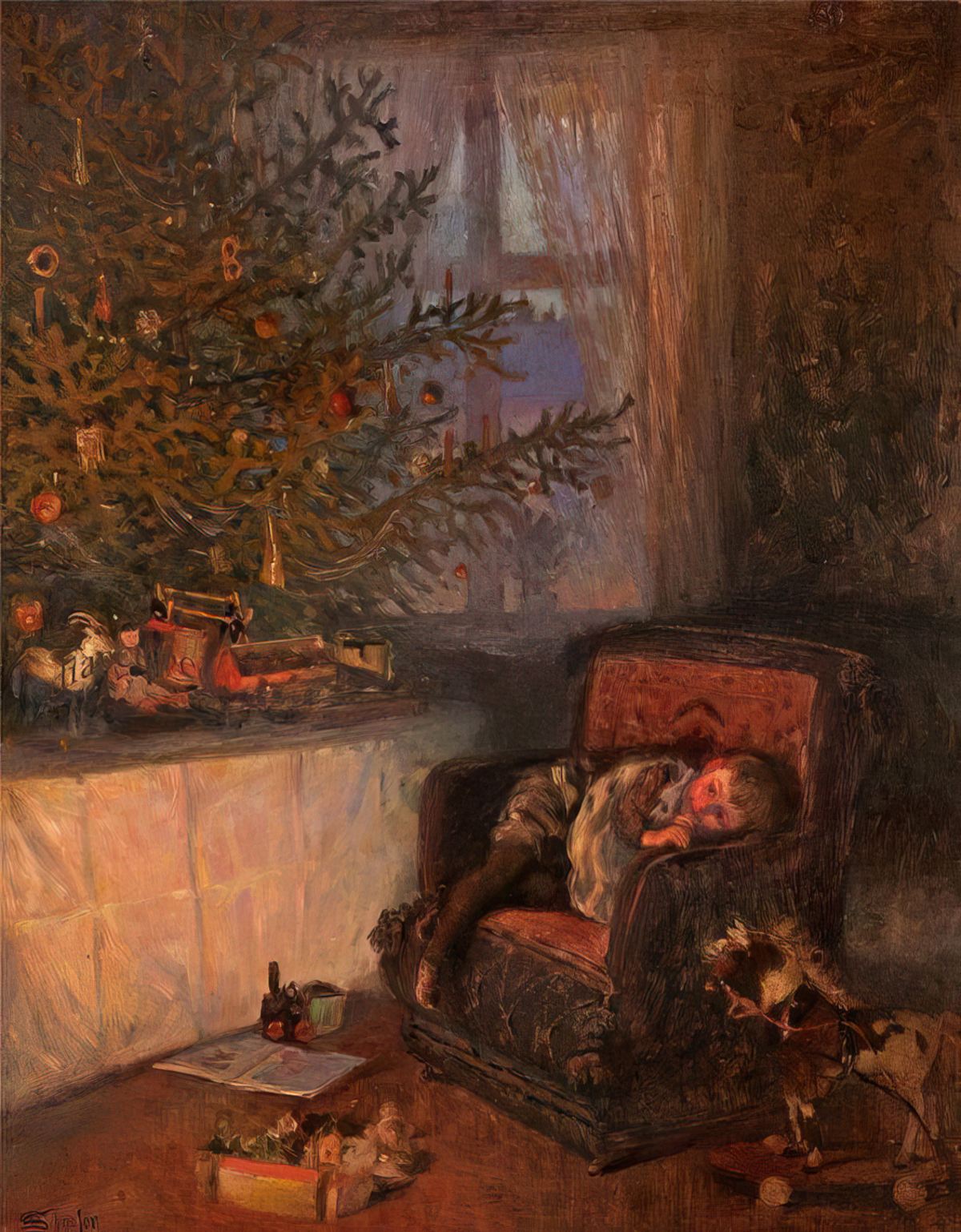
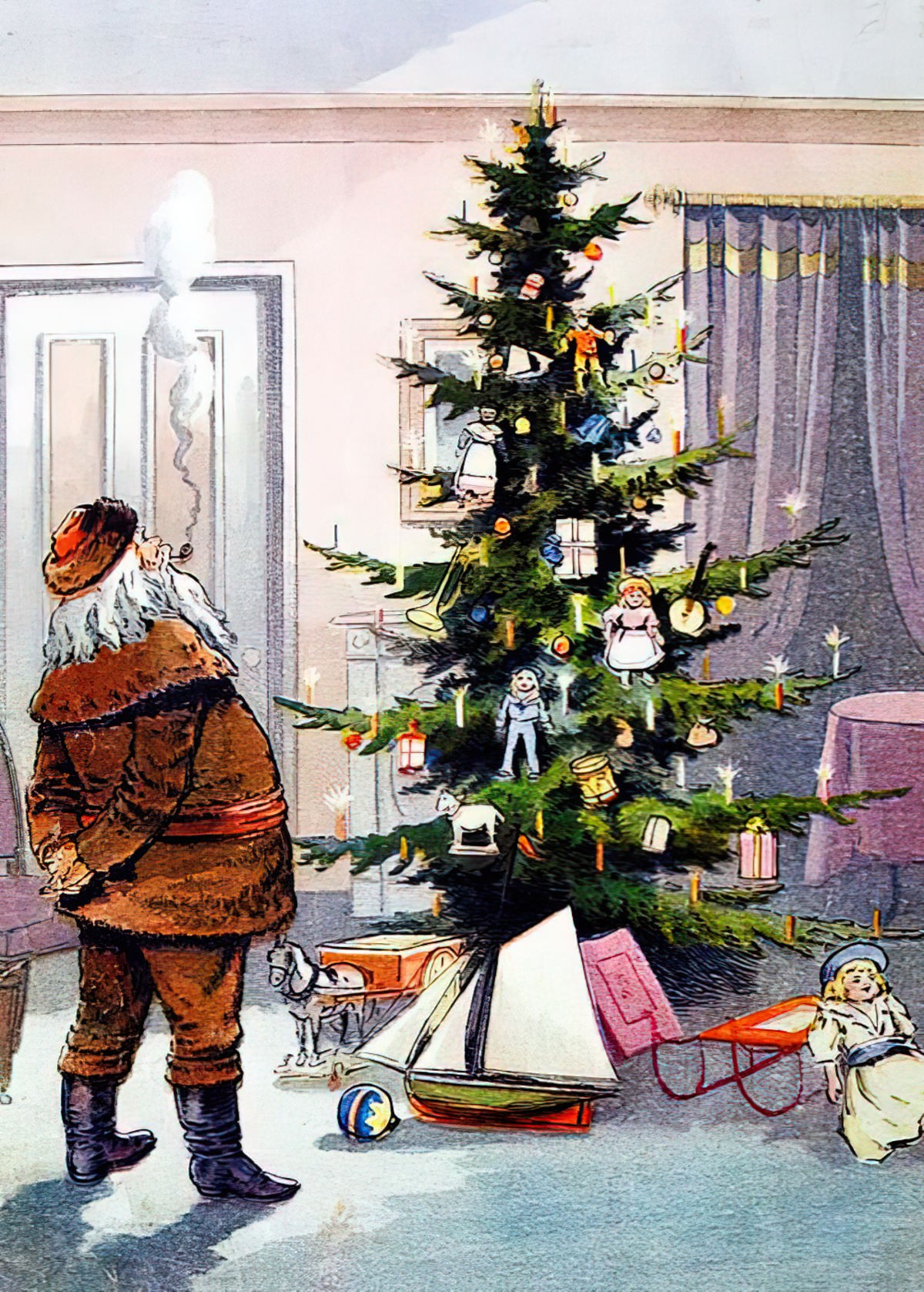
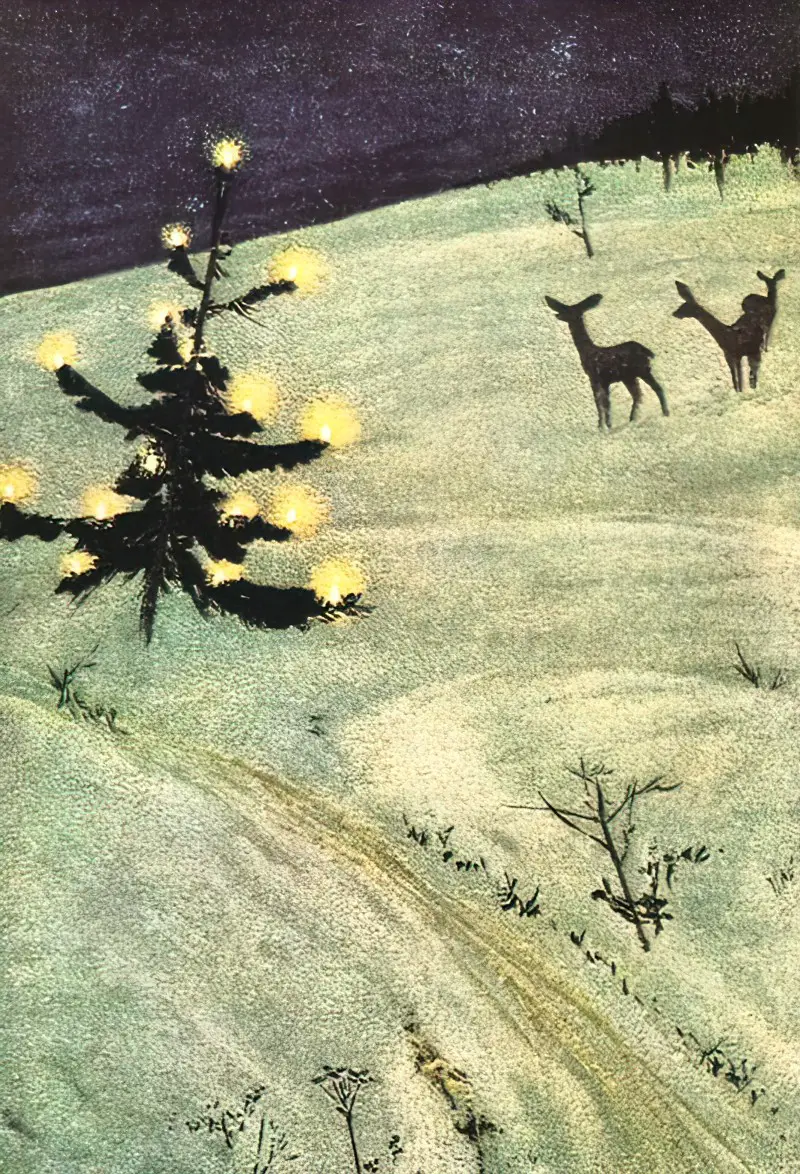
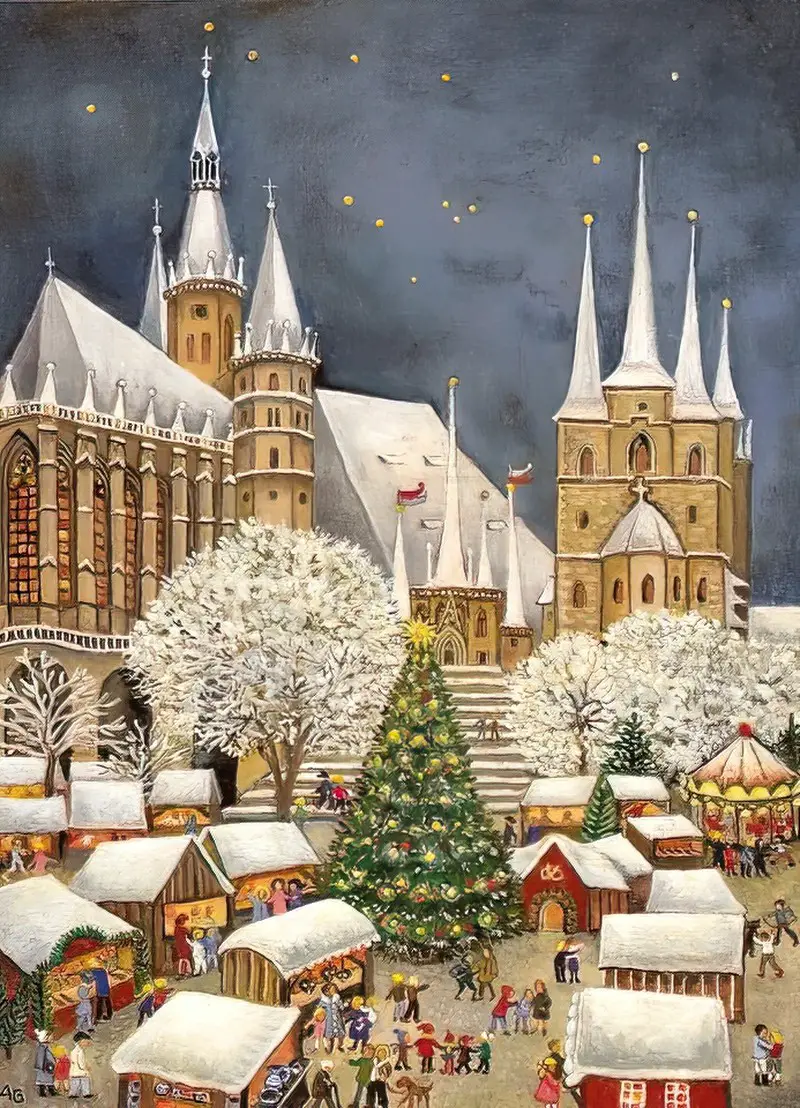
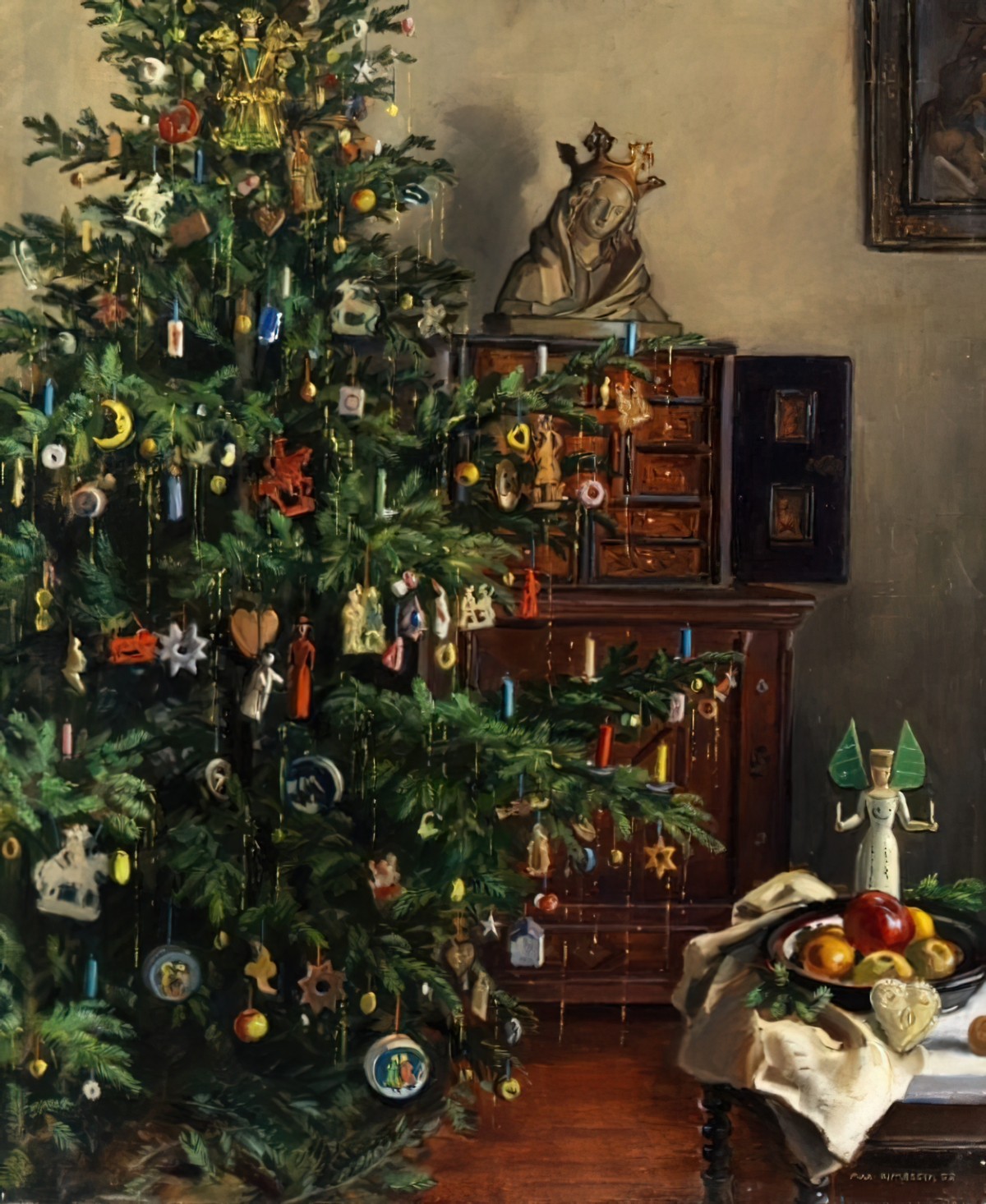
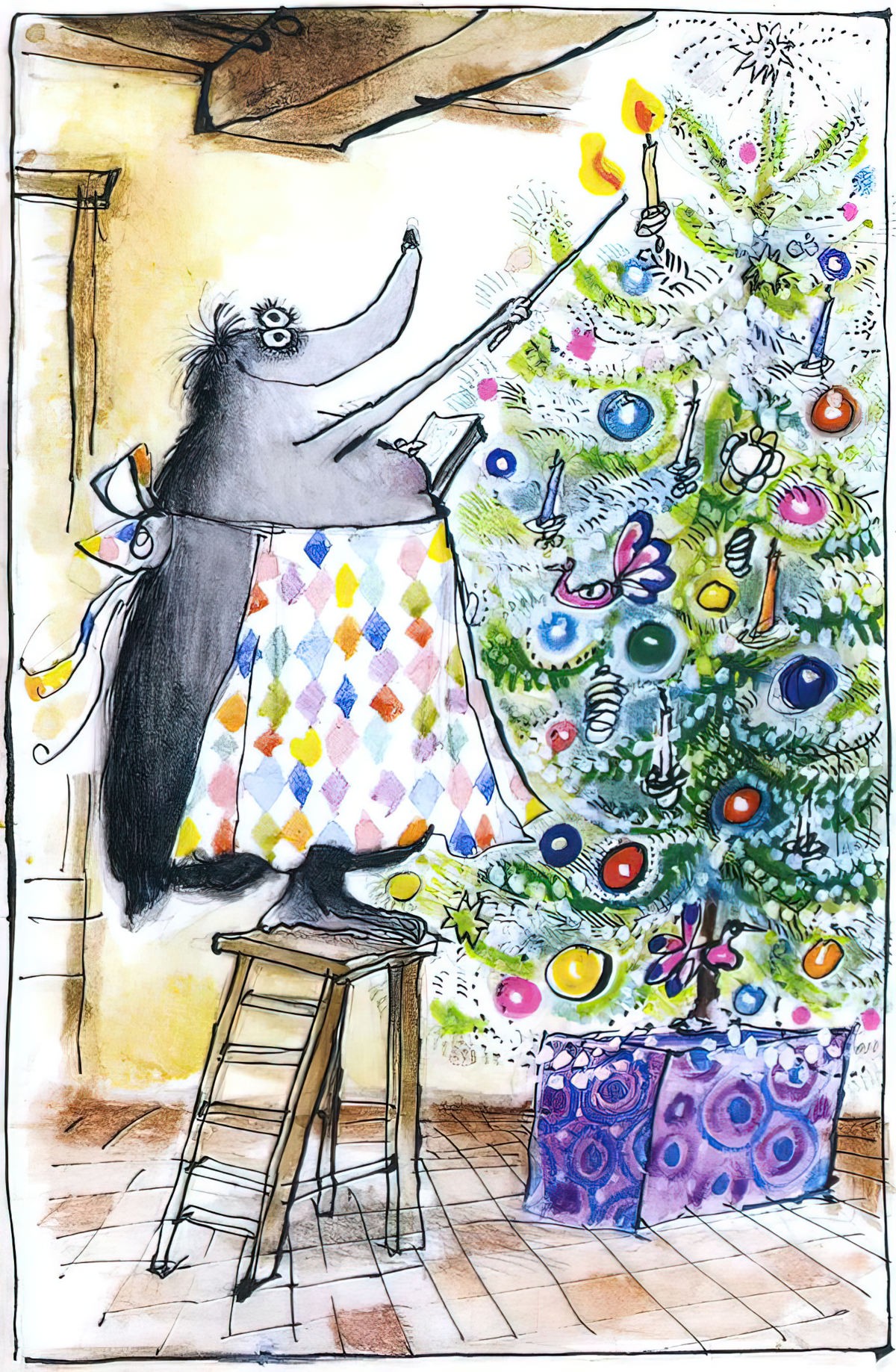
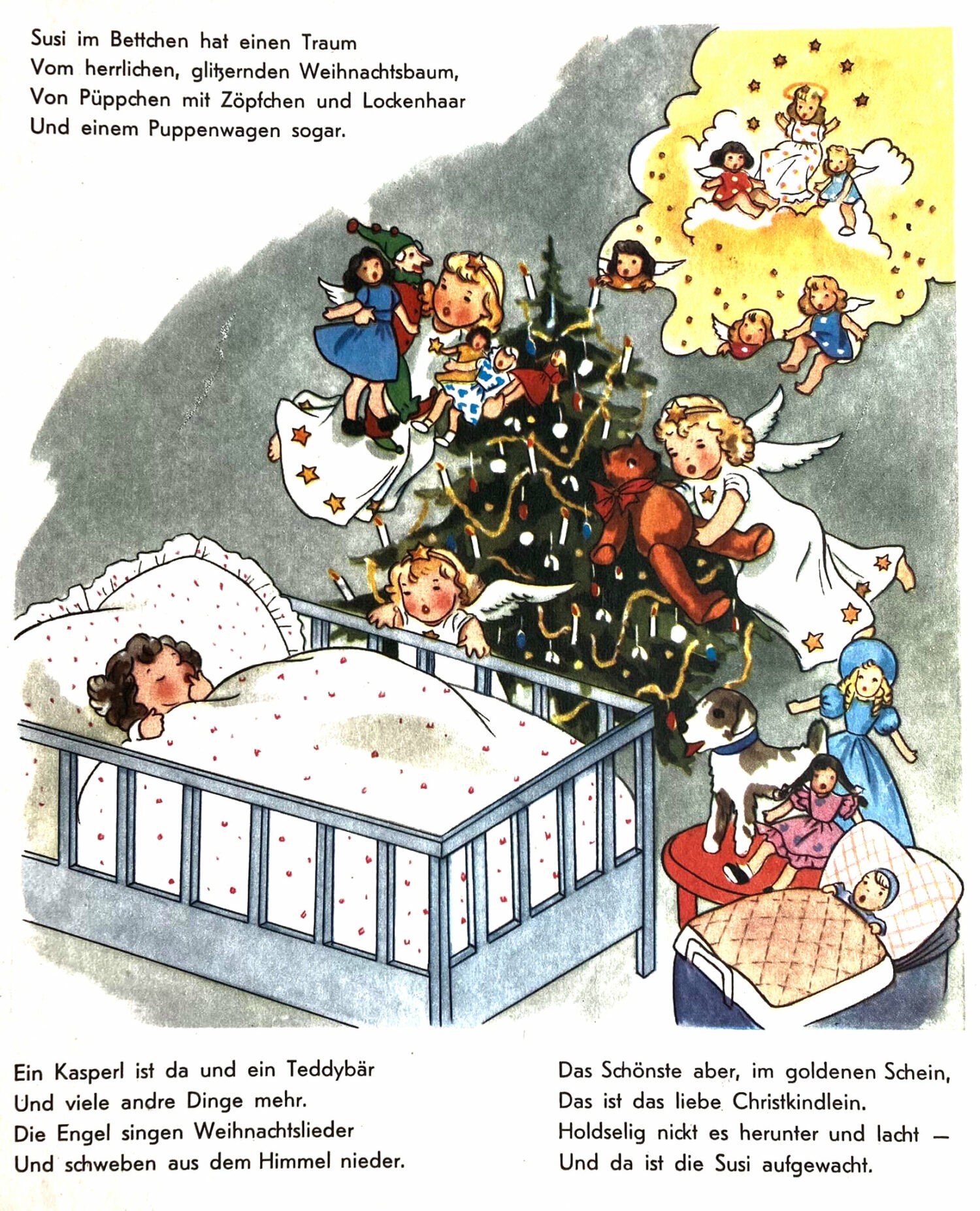
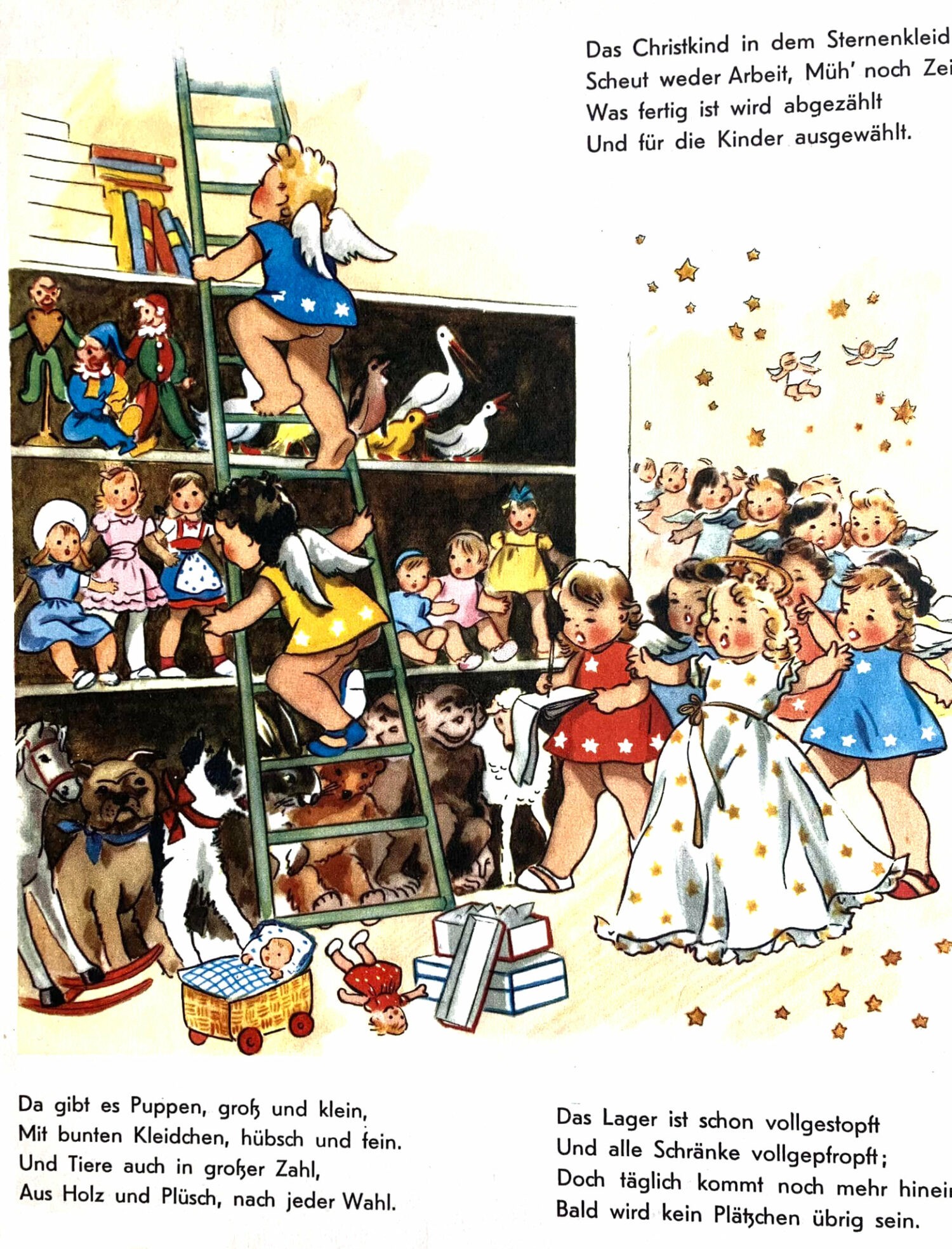
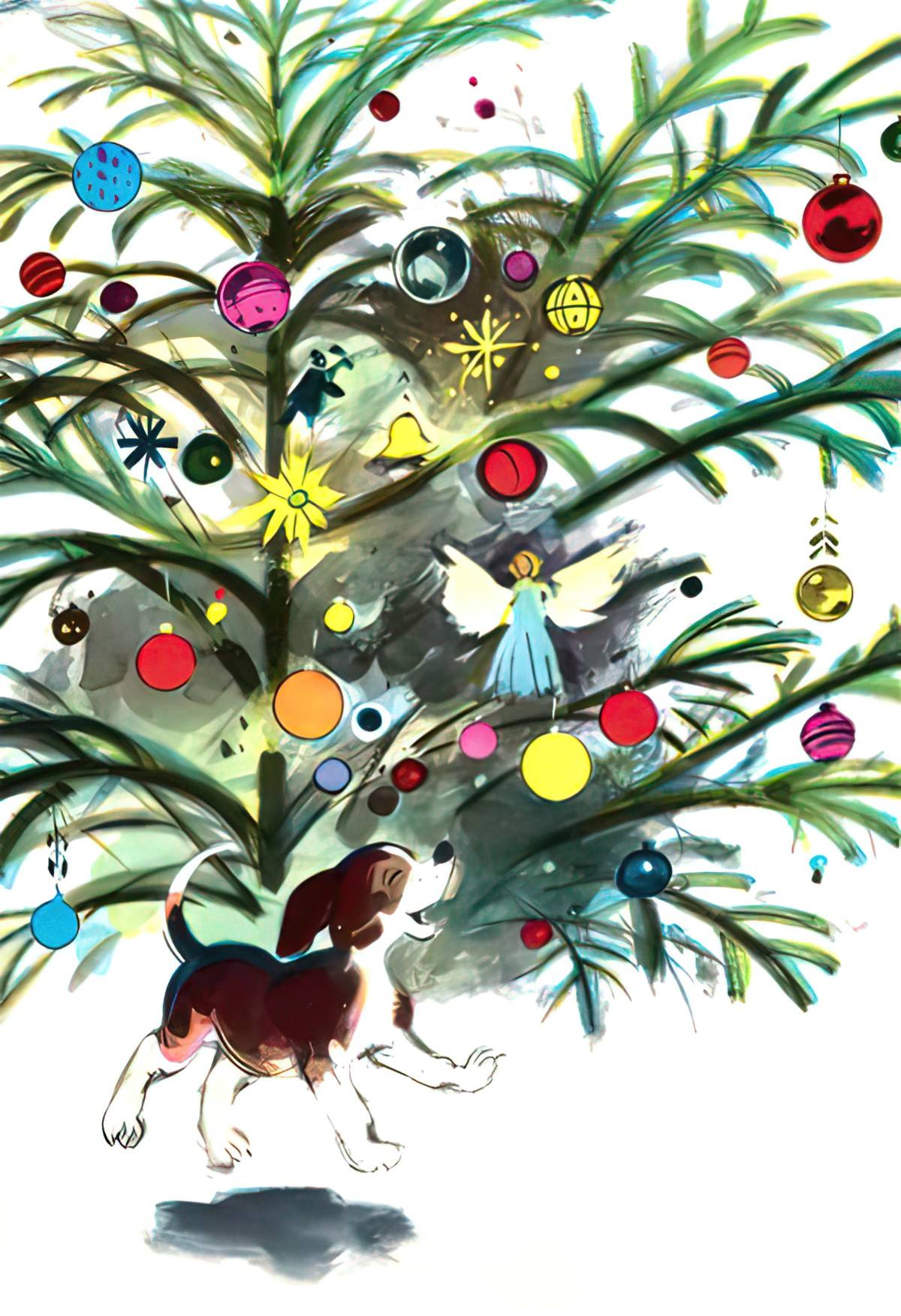
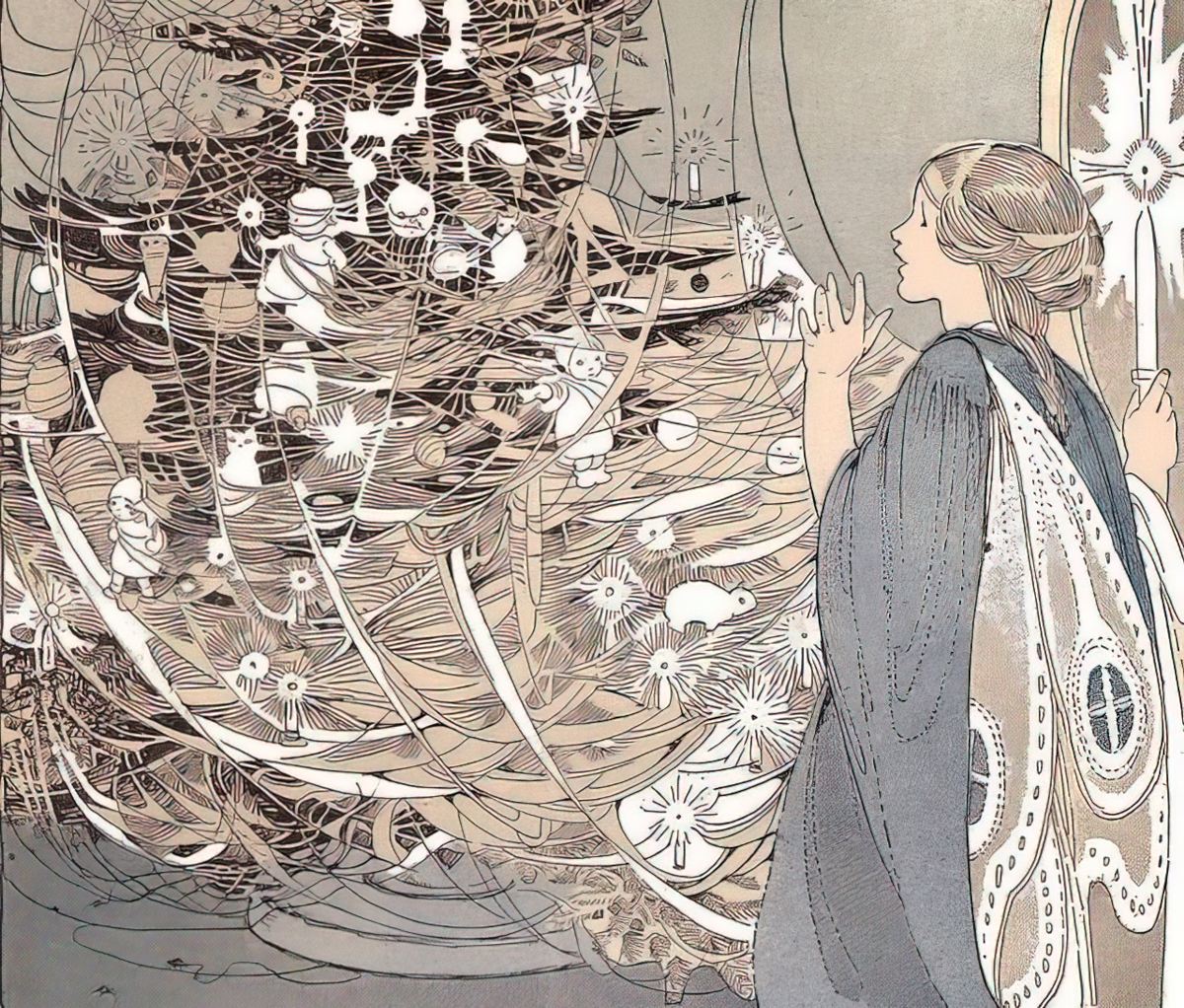
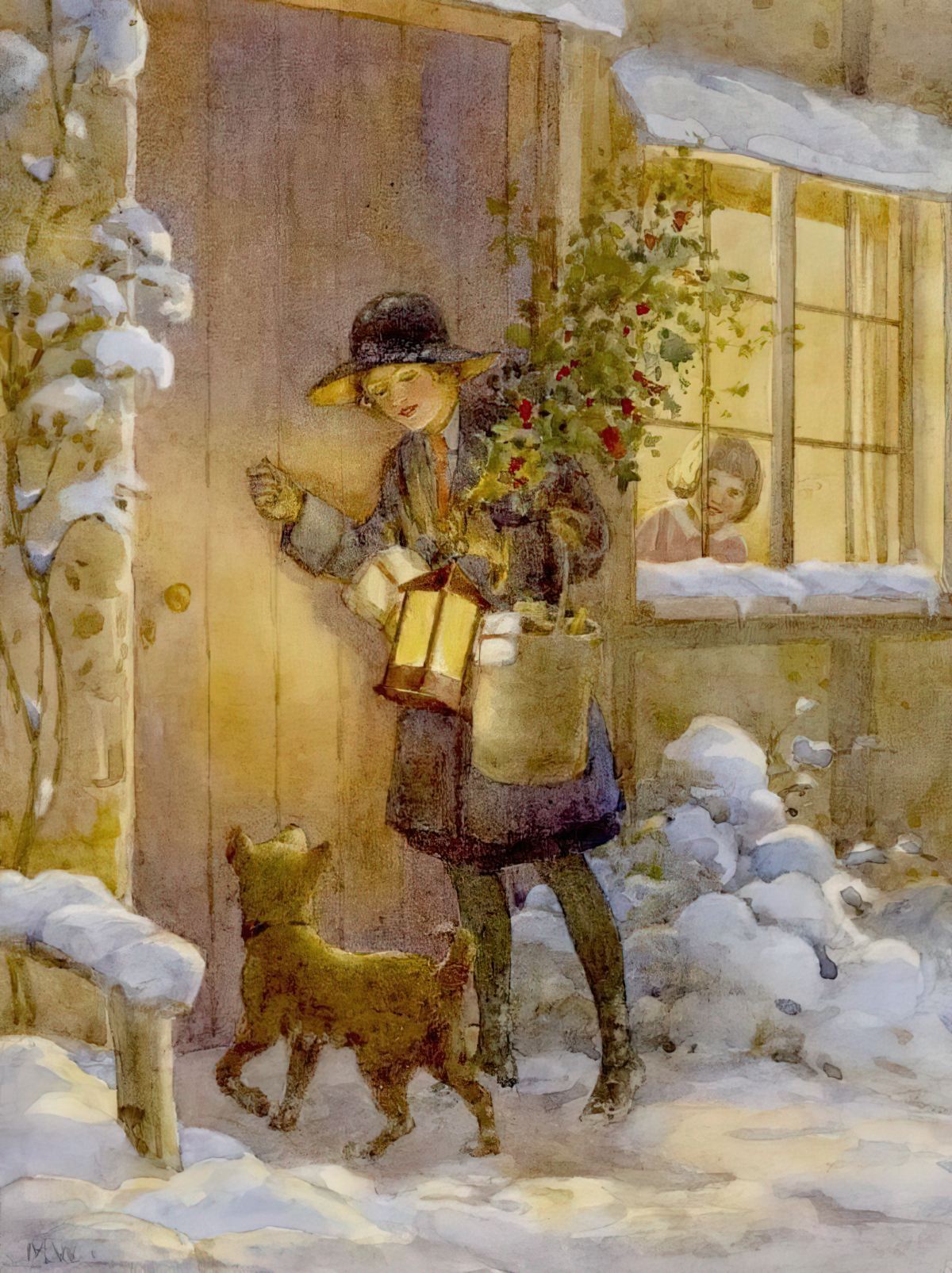
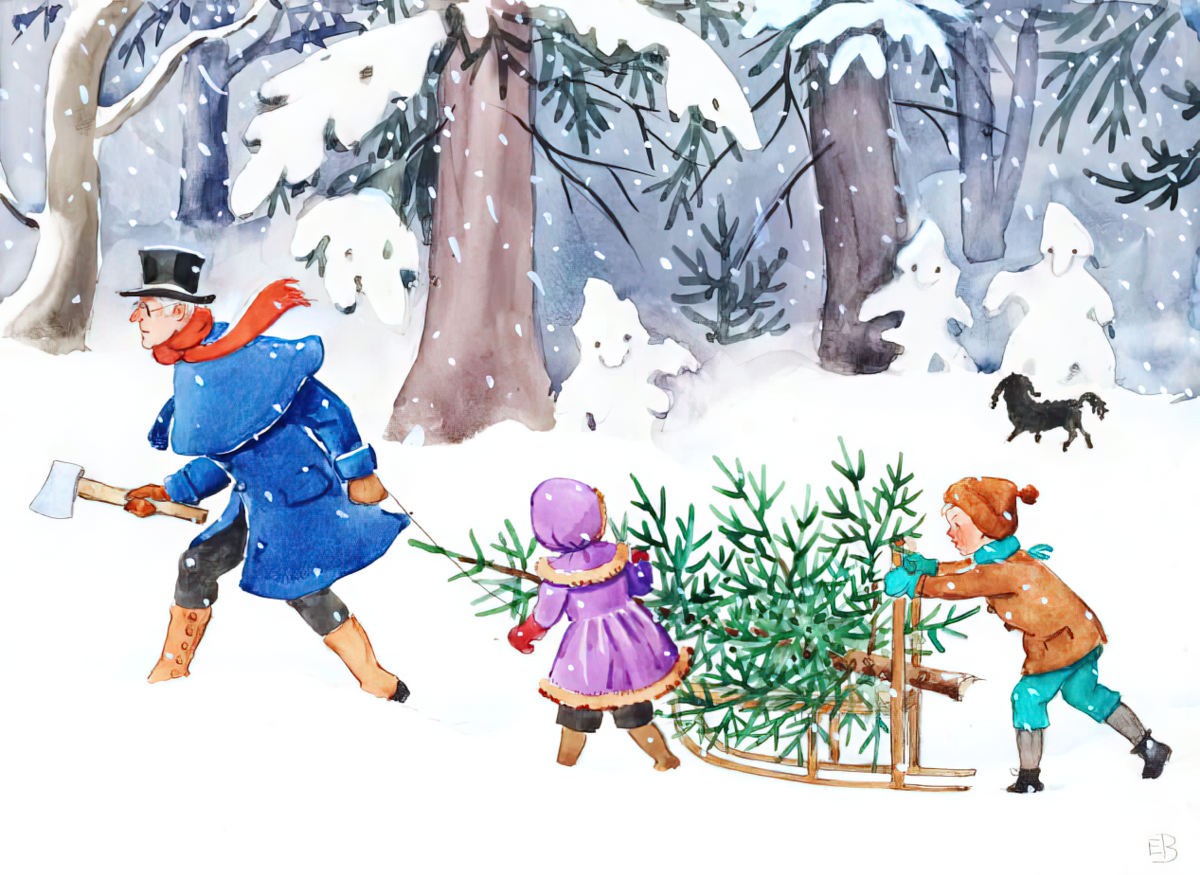

Finally I found one! Another droopy-branched Christmas tree, from Italy:
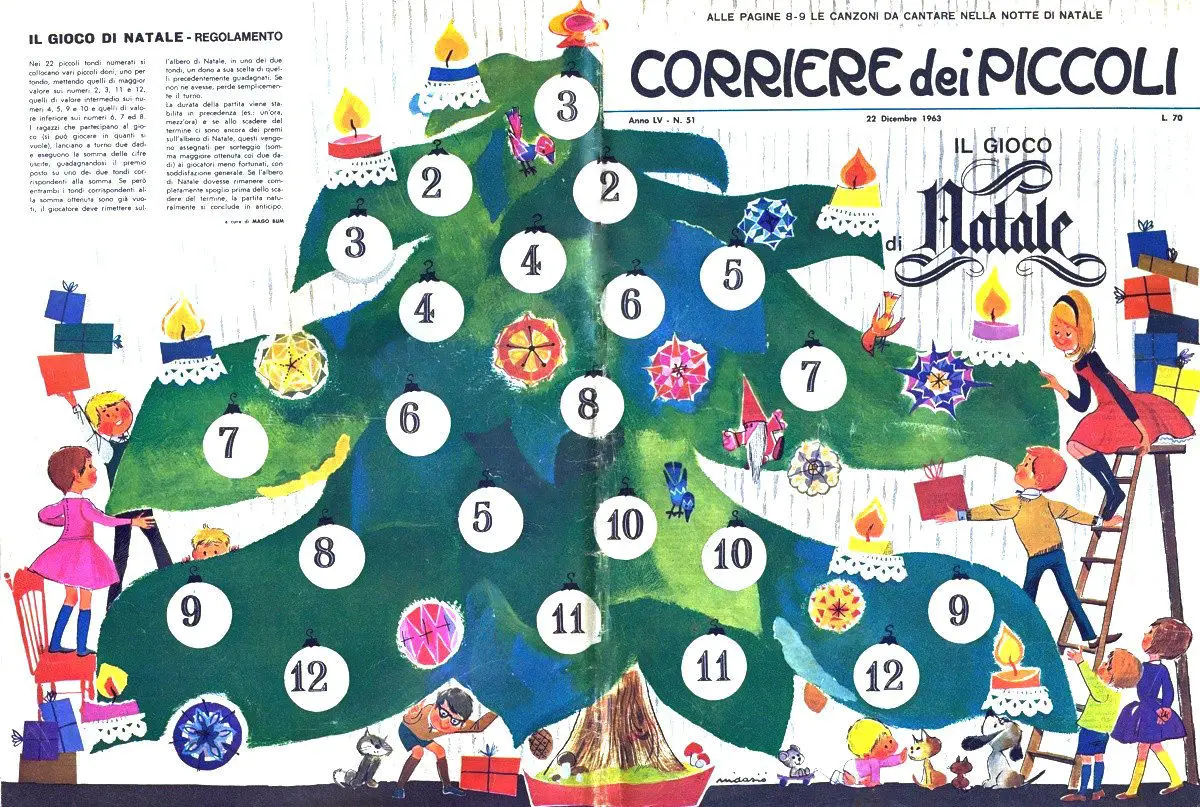
And here are some more from children’s literature:
